

The people’s war against the novel coronavirus (COVID-19) epidemic is entering a decisive stage in China. Under the strong leadership of the central government, the whole nation has devoted tremendous amounts of resources and efforts to this war. The prevention and control of the epidemic in Hubei, especially in such heavily-hit areas as Wuhan, has become a key campaign; and the measures taken by other Chinese regions will determine whether this war will turn to be a war of attrition or a protracted war. For now, a few questions remain for the international community concerned about how soon China will totally conquer the coronavirus: When will be the turning point of the epidemic? What new measurers and efforts have the Chinese government and people taken to fight against the epidemic and with what effects? What new progresses have been made by the Chinese medical community in epidemic control and treatment to COVID-19 patients? And what lessons can be learned by the international public health circles from this war against an epidemic of even greater impact than the severe acute respiratory syndrome (SARS) epidemic in 2003? This report gives latest answers to those questions from a special research team at Shanghai Institutes for International Studies (SIIS).
The reports concludes that at present, the COVID-19 epidemic manifests a trend of localized clusters of outbreak (especially in the City of Wuhan and some other areas in Hubei Province) but coming increasingly in check in other parts of China. The situation in Hubei, Wuhan and other regions is expected to be further improved with enhanced national strategy and measures. Nevertheless, the turning point of the epidemic will depend on the effectiveness of the current prevention and control measures, as well as cooperation of the general public. In the next week or two, China will be faced by new challenges as millions of people return to work in major cities after the Spring Festival. If the number of new infections can be kept low for two weeks, then we can say the turning point has come in China except for Hubei.
This report points out that although there is still no direct cure for COVID-19, China’s government branch in charge of epidemic prevention, medical institutions and medical researchers have joined hands in optimizing the epidemic control strategy and patient treatment plans. It proves increasingly effective to detecting, confirming, and treating infected people at the earliest time, as well as to rescuing severely ill patients and reducing mortality rates.
It is also pointed out that China’s whole-of-government approach and efficient social mobilization system are the basic guarantee for victory of the people’s war. The many unconventional measures adopted so far -- such as rushing medical staff and other resources to Wuhan from around China, assigning 19 provinces or municipalities to each help treat severely ill patients in a specified area in Hubei, instituting workfrom-home arrangements, and calling for the public to stay home unless necessary -- all will help China to win the war against the epidemic.
As this report believes in the end, China’s ongoing people’s war against COVID19 epidemic can lend many lessons and inspirations to the international community for combating pandemics in the future. In the globalized era, the world is yet to be ready for pandemics breaking out in mega-cities. How to strengthen the response capabilities of local public health systems in face of an epidemic? How to gather and coordinate various resources of a nation for effective epidemic prevention and control? And how to enhance the sense of a community of shared future for mankind and reinforce joint efforts of the international community against a pandemic? The key to those questions lies in solidarity of the nation, scientific prevention and control measures, and strengthened international cooperation. I firmly believe this people’s war against the epidemic will give much enlightenment to both China and the international community.
China's Fight Against COVID-19 Epidemic: A Decisive Campaign
China is arriving at a critical moment in the war against novel coronavirus epidemic (COVID-19). According to statistics, although the absolute number of confirmed diagnoses is still increasing, its growth rate has begun to show a downturn in China except for Wuhan and a few other areas in Hubei province. Through joint efforts of the whole nation, China’s highest-level prevention and control measures have proven quite effective, with the spread of the virus slowing down and the diagnosis and cure rates on a steady rise. Thanks to timely adjustments of the national strategy and measures in epidemic control, the impact of COVID-19 epidemic on Wuhan, Hubei, and elsewhere in China has been increasingly contained: on one hand, the unceasing inflow of various national resources is ushering in a turning point in the fight against the epidemic in Wuhan and Hubei; on the other hand, imported infections and subsequent spread of the virus in other regions have been under ever tighter control as a result of strengthened measures targeted at the local situations.
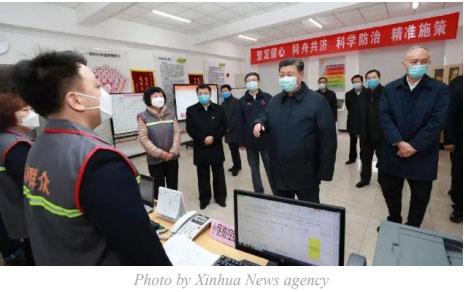
At present, the Chinese government and society are sparing no effort to win the war against the epidemic: rushing medical staff and other resources to Wuhan from around China, assigning 19 provinces or municipalities to each help treat severely ill patients in a specified area in Hubei, legislating for scientific prevention and control of the epidemic by the People’s Congress in many places, instituting work-from-home arrangements, mustering intelligence support from internet companies, and calling for the public to stay home unless necessary. All these unconventional moves are helping China to win the race with time.
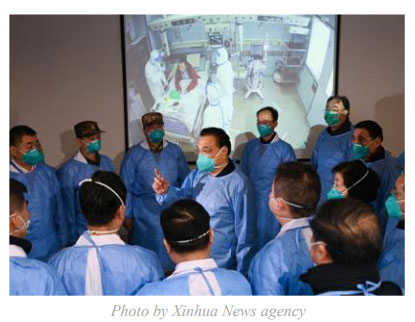
China’s Prevention and Control Measures Are Taking Effect
First, statistics have shown that the epidemic has been kept in check. Nationwide, except for Hubei province, the growth rates of confirmed infections, suspected cases, and patients under medical observation are all a steady decline. To be more specific, newly confirmed cases in places other than Hubei had decreased, for eight days in a row, from 890 on February 3 to 312 on February 12. On February 12, according to the fifth edition of Guidelines on Novel Coronavirus Diagnosis and Treatment, Hubei health authorities counted clinically diagnosed cases as confirmed, which resulted in a
sharp increase in new confirmed cases. This broadened diagnosis criteria further reflects China’s enhanced diagnostic capacity and the principle of “leaving no one unattended or under-attended.” (Figure 1)
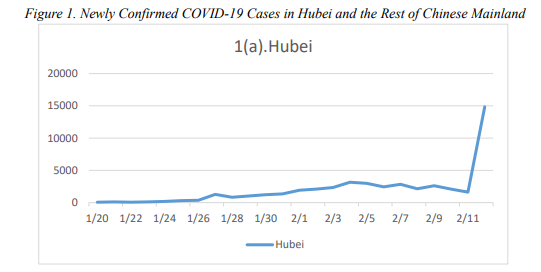
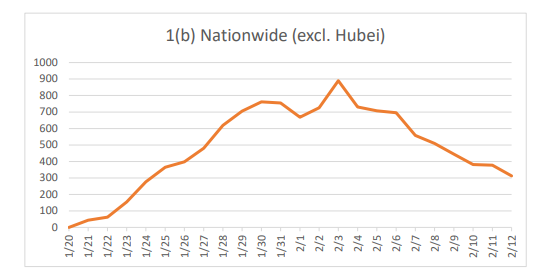
Nationwide, the spread of the deadly virus has been effectively curbed. Although the adoption of a new diagnosis criteria resulted in a sharp increase in reported newinfections and death toll on February 12 alone, the growth rates of both categories were lower than those during the peak moment. The growth rate of confirmed cases decreased from 64.54% on January 27 to 33.93% on February 12; that of COVID-19- associated deaths decreased from the peak of 64% on January 24 to 22.82% on February 12. Moreover, suspected cases and patients under medical observation were also on the decline. Suspected cases registered a negative growth rate of -16.38% on February 12 compared with 173.77% on January 23, while the growth rate of patients under medical observation decreased from as high as 253.52% on January 22 to a negative rate of - 1.97% on February 12. (Figure 2)
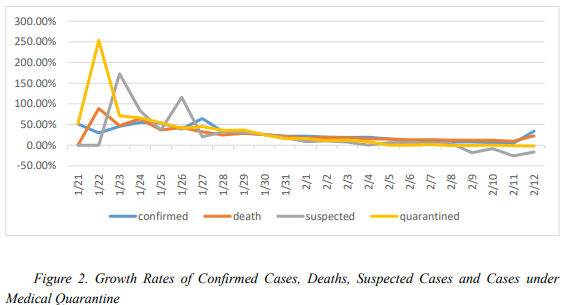
Second, the epicenter of the epidemic has been confined to such areas as Wuhan, Xiaogan, and Huanggang in Hubei, while the confirmed cases in other regions in China are relatively few and mainly imported ones. On the whole, Hubei has witnessed the majority of confirmed cases, severe cases and COVID-19-associated deaths in China. As Figure 3 shows, between January 20 and February 12, COVID-19-associated deaths in Hubei were 95% of the national number (1,310 out of 1,368); severe cases in Hubei were 88% (7,084 out of 8,030); and confirmed cases in Hubei were 80% (48,206 out of 59,804). After the peak of imported cases, other regions in China have had no new outbreak thanks to the strong prevention and control measures nationwide.
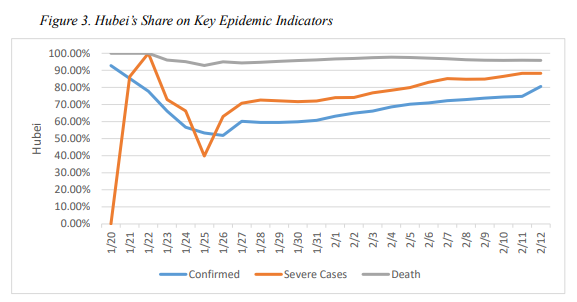
Third, the growth of severe cases around China is slowing down and the rehabilitation rate has surpassed the death rate. As a key indicator to the severity and fatality of the epidemic, severe cases have been under most meticulous treatment and with utmost care. As a result, the death rate had dropped from over 100% on January 20 to a negative rate of -2.17% on February 12.(Figure 4)

Fourth, the COVID-19-caused mortality rate is on a steady decline. As shown by the daily ratio between accumulated deaths and severe cases, the mortality rate has been decreasing significantly in Hubei (from 40% on January 25 to 18.49% on February 12) and remains low (well below 10%) in other regions of China (Figure 5).
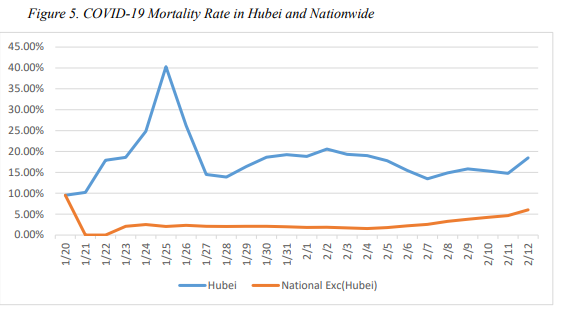
Fifth, with deeper understanding of the coronavirus and enhanced effectiveness of medical treatment, the number of cured patients has kept rising -- from 34 by January 23 to 5,911 by February 12 nationwide. Besides, the number of cured patients has begun to exceed that of COVID-19-caused deaths since February 1, with 24 more cured cases on February 1 to 4544 on February 12 (Figure 6). In Shandong, Zhejiang and a few other provinces, the number of cured patients has even begun to surpass that of confirmed cases.

The war against COVID-19 epidemic has come to a critical moment. Currently, there are two major views on when the turning point will be. Prudent optimists think that it will come sometime between February 10 to 15, right after China’s Lantern Festival. According to Professor Zhong Nanshan, academician of Chinese Academy of Engineering, director of the National Clinical Research Center for Respiratory Disease, and head of the High-level Panel of Experts, the latent period of the novel coronavirus is usually 3 to 7 days and 24 days at maximum. With the nationwide restrictions on population flow, both the peak and turning point of the epidemic will appear around the Lantern Festival.2 On this trend, the epidemic may be over by the end of April.
Pessimists, however, predict that the turning point will come as late as April, with confirmed cases surpassing 70,000. For instance, a research done by Professor Joseph T. Wu’s team at the School of Public Health, Li Ka Shing Faculty of Medicine, Hong Kong University, published on The Lancet on January 31, forecast the turning point of the epidemic to appear in April based on latest mathematical modelling. Meanwhile, the research points out that “[t]o possibly succeed, substantial, even draconian measures that limit population mobility should be seriously and immediately considered in affected areas, as should strategies to drastically reduce within-population contact rates through cancellation of mass gatherings, school closures, and instituting work-fromhome arrangements, for example.”Now that all the recommended measures have been adopted, the gloomy forecast is not quite likely to become reality.
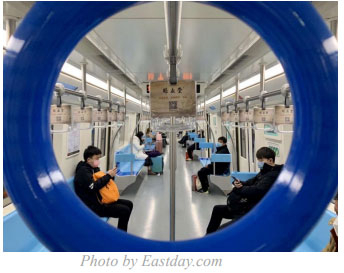
In fact, the turning point of the epidemic not only depends on the objective laws of the development of the novel coronavirus, but it is also a function of the collective efforts of the Chinese government and people. As Professor Chen Wei, academician of Chinese Academy of Engineering and researcher at the Institute of Military Medical Sciences of the PLA Academy of Military Sciences, warns, although the turning point is coming soon, the possibility of recurring of the epidemic still remains, and thus it is necessary to plan for the worst and make fullest preparation for long-term fight against it. In the same vein, Mr. Zhang Wenhong, director of the Department for Infectious Diseases at Huashan Hospital Affiliated to Fudan University and a member of the Shanghai special medical team for COVID-19, calls for support from the general public, saying that “staying home and refraining from going out is also a contribution to our fight [against the epidemic].
Therefore, it is believed that despite the positive progresses in prevention and control of the novel coronavirus, the turning point of the epidemic will be determined by further endeavor of the Chinese government and people. China is facing new challenges especially in the next one to two weeks, as millions of people from all over the country are returning to work in mega-cities after the Spring Festival. If the number of new infections remains low two weeks later, it can be said that the turning point has come except for Hubei.
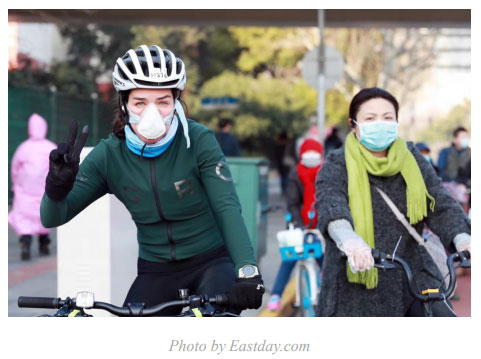
In general, strong epidemic control, effective medical treatment to COVID-19 patients, and enhancing rehabilitation rate are three interrelated key missions of China’s war against the epidemic. Only when all of them are achieved, can China win the war in the shortest time.
Above all, a decrease of new confirmed and suspected cases will be the most direct indicator of the turning point and a clear proof of the effectiveness of the prevention and control measures. At present, despite the increase of the absolute number of new confirmed and suspected cases, its growth rate has been on the decline for days. If such trend continues for another week or two, then the first mission will be accomplished.
Next, as the biggest threat to public health, severe cases and COVID-19-caused deaths are the main roots of public fear of the epidemic. A decreasing number of severe cases and deaths will indicate that the medical treatment is taking effect and that the severity of the epidemic is in check. Up to now, the mortality rate of COVID-19 has remained rather low except in Hubei, which means the epidemic has been under tight control in most Chinese regions. After classified treatment and a greater number of intensive care unit (ICU) facilities are introduced in Hubei, the mortality rate there is expected to shrink as well.
Finally, the ultimate victory will be achieved when all COVID-19 patients are cured. Now, the rehabilitation rate is increasing steadily with enhanced measures and capabilities of medical treatment, while the public has developed more understanding about COVID-19 and strengthened self-protection. Both will help reduce the number of new cases and augment the rehabilitation rate.
Optimizing Epidemic Prevention and Control Strategies and Medical Treatment Guidelines
According to the World Health Organization (WHO), there is no direct cure or treatment for COVID-19. Thus, early detection, quarantine and treatment remain the most effective method to contain the coronavirus. The National Health Commission (NHC) has classified COVID-19 as a Category B disease requiring Category A measures in accordance with China’s Law on the Prevention and Treatment of Infectious Diseases. Supported by the government and in partnership with their international counterparts, Chinese medical institutions have taken relentless efforts to improve medical treatment of patients and made remarkable achievements. So far, the NHC has released Guidelines for COVID-19 Prevention and Control and Guidelines for COVID-19 Treatment and is updating them according to latest developments. The Ministry of Science and Technology, NHC, and National Medical Products Administration are also supporting research institutions and pharmaceutical companies in their efforts to screen and evaluate the most efficient drugs from all available or under-development medicines. Moreover, the central leading group on COVID-19 prevention and control is organizing resources of all levels to minimize the epidemic’s impact on psychological well-being of eligible people.
Adapting Prevention and Control Strategies to Latest Developments
Based on existing knowledge of the novel coronavirus, the 4th edition of the Guidelines for COVID-19 Prevention and Control emphasizes the importance of effective mobilization and timely coordination among all medical institutions and underscores the imperative of adherence to the principles of “early detection, early reporting, early diagnosis, early quarantine, and early treatment.” Besides, it has updated the monitoring methods, epidemiological survey tactics, and restrictive measures regarding close contacts and asymptomatic infections. For example, it specifies how to detect asymptomatic infections and outlines the requirements that have to be met before those asymptomatic patients can be discharged from medical observation; meanwhile, concentrated quarantine is requested for close contacts in regions with adequate resources.
Enhancing Capacity of Pathogen Detection and Clinical Diagnosis , Choosing Treatment Sites According to Patients’Conditions
Effective quarantine is most important for epidemic containment; and the improvement of detection diagnosis rates is key to patient identification. 2019-nCoV cases are mainly confirmed through nucleic acid tests. At the early stage of the epidemic, large numbers of infections were left unconfirmed and unreported due to deficiencies in testing methods, equipment, and techniques. As Wang Chen, a pulmonologist at the Chinese Academy of Engineering, said on February 4, “the two crucial issues in the current fight against the virus are improving the detection and diagnosis rates by increasing the amount of nucleic acid testing; and gathering all confirmed cases with mild symptoms for quarantine to prevent wider spread.” At present, 40 testing institutions in Wuhan have been authorized to conduct testing of up to 10,000 persons per day. As our understanding of and clinical experience in treating the disease grow, the NHC has released the fifth edition of Guidelines on Novel Coronavirus Diagnosis and Treatment in which the category of clinical diagnosis is added to give confirmed cases the earliest possible standard treatment and improve the cure rates.
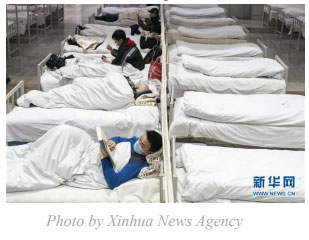
In Relentless Search of Effective Medicines and Treatment Options
Medical research institutions and pharmaceutical companies around the world have been engaged in the endeavor to find the most effective treatment and drugs. As of February 6, there had been 36 clinical trials related to the novel coronavirus registered at the Chinese Clinical Trial Registry, covering a wide range of research domains, including Western medicine clinical research, traditional Chinese medicine (TCM) treatment, traditional Chinese-Western hybrid treatment, psychotherapy, and postrecovery rehabilitation. Approved by the National Medical Products Administration, a medical task force led by Wang Chen and Cao Bin of China-Japan Friendship Hospital launched Phase III of Remdesivir Clinical Trial on February 5. At the same time, Chinese experts have identified a number of Western and Chinese-patent drugs as potentially effective in containing the virus, such as Chloroquine, Arbidol, Darunavir, and Favipiravir; related animal tests and clinical trials are being conducted.
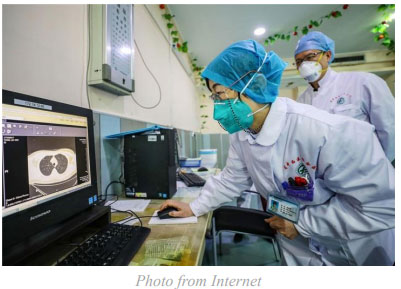
Exploring TCM’s Unique Advantages
Apart from Western medicine and medical treatment, medical institutions in China are also exploring what role TCM can play in the fight against the virus. Eight patients, including six severe cases, were cured and discharged from Jin Yin Tan Hospital in Wuhan on February 3 after receiving TCM and traditional Chinese-Western hybrid treatment by experts from Guang’anmen Hospital and Xiyuan Hospital, two preeminent hospitals affiliated to the China Academy of Chinese Medical Sciences. As Dr, Li Guangxi, dean of the Department for Respiratory Diseases at Guang’anmen Hospital, put it, traditional Chinese medicine has accumulated many best practices in fighting off infectious diseases and is now demonstrating its unique advantages in combat with the novel coronavirus. Thus, the 5th edition of China’s Guidelines for COVID-19 Treatment advises medical institutions to “give full play to TCM treatment, enhance traditional Chinese-Western hybrid approaches, and set up joint traditional Chinese-Western diagnosis and treatment mechanisms......to find out the treatment scheme most suitable to the actual conditions of patients and local weather conditions.”
Providing Timely Support for Psychological Well-being of the Public
Psychological crisis intervention is also included as part of the effort to minimize the impact of the COVID-19 epidemic on the psychological well-being of eligible people. To this end, two documents, Guiding Principles for Emergent COVID-19-Caused Psychological Crisis Intervention and Guidelines for Psychological Aid Hotline during COVID-19 Outbreak, have been released. Various free hotlines have been set up to provide a wide range of services (such as counselling, psychotherapy, and crisis intervention) to comfort and help those in distress or mental disorder caused by COVID-19.
Full Governmental and Social Mobilization in China
A Race with Time
Time holds the key in the current war against COVID-19 epidemic; and victory depends on how much faster nationwide mobilization for assistance to Wuhan and Hubei comes before the spread of the deadly virus. Among the 9 million residents in locked-down Wuhan are those already under medical treatment and infected people who carry the virus in latency. Whether these asymptomatic carriers can be put under proper treatment in the fastest possible way is another key factor, as long delay may lead to family and community transmission on a much larger scale. Therefore, the central government is mobilizing and coordinating steady supplies of medical equipment and materials for Wuhan and Hubei, the front-line areas where tailored and targeted measures have already been adopted to build up local capacity in patient admission and treatment.
First, a precisely tailored system has been established to leave no patient unattended or under-attended. Severe patients are treated in designated hospitals, while patients with mild symptoms are sent to other specified institutions. Suspected cases with fever will remain in fever clinics under medical observation. Patients with CT-confirmed lung inflammatory signs are gathered in institutions isolated from suspected cases to prevent cross infection. Close contacts with confirmed cases are monitored in either collective or at-home quarantine.
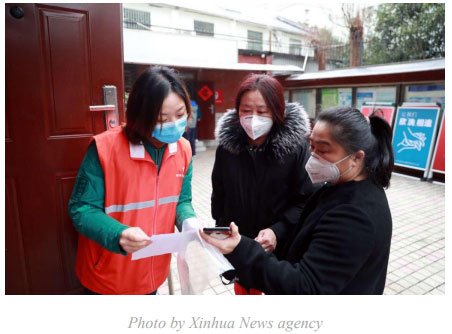
Second, a three-level quarantine model has been put in place to improve medical resource allocation. The two new hospitals, Leishenshan and Huoshenshan, and other remodeled institutions have added 8,000 beds for severe patients in Wuhan and more than 10,000 beds are expected to be ready for use as more institutions are modified to admit patients. Three makeshift hospitals known as “square cabin” hospitals have been erected in Wuhan to provide 4,400 beds for patients with mild symptoms; and altogether more than 10 such hospitals will be ready for use soon. Hotels near hospitals have be temporarily turned into places for quarantine for potential virus carriers. So far, Wuhan has had 132 such facilities with 12,571 beds. This three-tiered quarantine model allowspatients in different conditions to receive the most appropriate treatment, which helps optimize the allocation of medical resources.
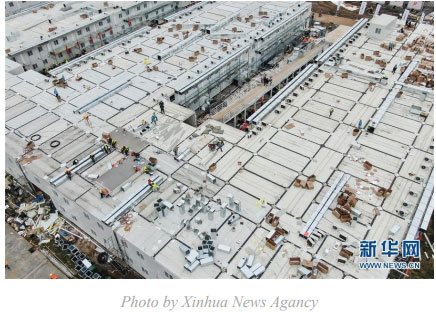
Third, the central government is mobilizing more resources from all over China to reinforce Wuhan in the war against COVID-19 epidemic. To “leave no patient unattended or under-attended” requires a continuous inflow of medical workers and materials. Thus, the central government has made it clear that “steady supply of materials for epidemic control in Hubei province, especially in Wuhan, is the top priority for the nation. The central government is in charge of coordinating provision of materials in short supply. Hubei must do its best in material management and allocation”; and that “more medical experts specializing in respiratory diseases, intensive care, and nursing will be sent to assist Hubei.” As of February 5, 107 medical teams of 10,596 professionals had been sent to Hubei, most of them working in Wuhan. Moreover, 19 provinces and municipalities have been assigned to each help treat severely ill patients in a specified area in Hubei.
Top Priority of the Nation
At present, local governments around China are shifting their focus from curbing Wuhan-exported cases to cutting off sources of potential family and community transmission. More vigorous measures are taken and best practices widely shared. For example, successful models of social governance in some cities are being replicated nationwide, such as setting up quarantine sites, building “square cabin” hospitals, canceling social gatherings, and shutting down venues for public events. Population mobility is restricted to the minimum level and local residents are advised to stay at home.

At the same time, public awareness of health and personal hygiene has been raised considerably in health education campaigns nationwide. The public is eager to learnanything about epidemic prevention and has begun to improve their diets and living habits. Health tips about respiratory diseases are perhaps the most popularized knowledge right now: for example, respiratory diseases are spread through contact, droplets and air; main symptoms include fever, cough, and diarrhoea; and wearing masks, washing hands often, using disinfectant, and sufficient ventilation can help protect against the diseases. As people come to realize that wild animals are the most likely hosts of coronavirus, many are calling for the government to totally ban the consumption and trade of wild animals.
To guarantee timely and effective measures in the war against COVID-19 epidemic, local authorities are clarifying the respective powers, rights and obligations of the government, enterprises, and individuals by emergency legislation. For example, the standing committee of the Shanghai People’s Congress has passed legislation authorizing the Shanghai municipal government to blacklist those who attempt to conceal their health conditions in the social credit system.
Great Contribution of Internet companies
Chinese tech giants are exploring how emerging technologies can be applied to help fight against the coronavirus. Tencent, Alibaba, Baidu, ZTE, iFLYTEK, and JD.com are all actively employing such technologies as big data, artificial intelligence, as well as 5G in long-distance diagnosis, screening, and medical services. Long-distance diagnosis services are used to reduce the likelihood of infection during hospital visits. Up to now, ZTE has launched a 5G long-distance diagnosis platform linking West China Hospital and the Chengdu Public Health Clinic Center; Tecent, Alibaba Health, and Ping An Health Cloud Company have also begun to offer online medical consultation services to reduce unnecessary hospital visits and prevent cross infection.
Big data analysis helps screening in public places. Megvii and Baidu have installed infrared sensors in some sections of Beijing Metro system to take passengers’ body temperature, improving the efficiency of suspected case identification in crowded public places.
AI algorithm helps confirm suspected cases much faster. Baidu has made its DNA sequencing algorithm and RNA structure prediction website available to medical research institutions. A whole-genome testing and analyzing platform -- jointly developed by the Zhejiang Provincial CDC, Alibaba DAMO Academy, and MATRIDX -- has considerably improved the speed and accuracy of confirmation of suspected cases.
In addition, AI technology has been widely applied to ensure medical supplies. For example, iFLYTEK has opened up its “AI+Office” platform to offer high-quality telecommuting services for enterprises and individuals. Zuoyebang.com provides longdistance education services. CloudMinds offers a number of multi-purpose robots to deliver goods and services in quarantine areas and to disinfect and clean wards.
Lessons Learned
Although the COVID-19 epidemic continues, China is well-positioned to win the ultimate victory against it. This monumental event offers China and the world a number of important lessons regarding international cooperation on global public health emergencies.
First, a globalized world featuring more densely-populated metropolitan areas with higher population mobility poses unique challenges for epidemic prevention and control. Although mega-cities have generally established full-fledged public health emergency response mechanisms, yet economic, political, social, and security concerns all magnify decision-makers’ and the public’s sensitivity to the outbreak of infectious diseases. Therefore, emergency response mechanisms, social mobilization systems, andreserve systems for strategic assets must be institutionalized in mega-cities. Besides, the competence of community-level officials and individuals’ public health awareness need to be improved through more training courses and mass education programs.
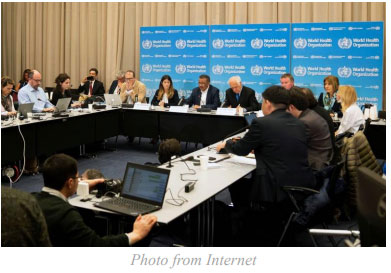
Second, China’s cross-region medical supply systems and coordinating networks for medical experts are playing a decisive role in the current war against COVID-19 epidemic. Rallying more than 10,000 medical professionals and coordinating huge amounts of medical materials to reinforce Wuhan’s public health systems at short notice is not only a result of the full functioning of the central and local governments, but also thanks to efficient logistics and professional/resource allocation. For sure, China can share its challenges and good practices with the international community.
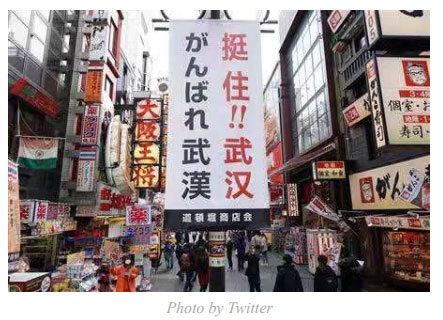
Last but not least, international cooperation proves increasingly important in the war against COVID-19 epidemic. In partnership with China, the WHO has been closely monitoring the epidemic and coordinating a concerted international response. National governments across the world have also extended a helping hand. As of February 7, more than 30 countries, including developing countries with medical supply shortages like Pakistan and Myanmar, have donated medical materials to China. Such acts of international humanitarianism indicate that in times of global emergency, international solidarity and coordination, rather than extreme rhetoric and excessive reaction, is what is needed for the well-being of the international community. For, as the Chinese saying goes, “Saving him to whom you’re tied from the river is saving yourself.”
Source: Shanghai Institutes for International Studies

 Award-winning photos show poverty reduction achievements in NE China's Jilin province
Award-winning photos show poverty reduction achievements in NE China's Jilin province People dance to greet advent of New Year in Ameiqituo Town, Guizhou
People dance to greet advent of New Year in Ameiqituo Town, Guizhou Fire brigade in Shanghai holds group wedding
Fire brigade in Shanghai holds group wedding Tourists enjoy ice sculptures in Datan Town, north China
Tourists enjoy ice sculptures in Datan Town, north China Sunset scenery of Dayan Pagoda in Xi'an
Sunset scenery of Dayan Pagoda in Xi'an Tourists have fun at scenic spot in Nanlong Town, NW China
Tourists have fun at scenic spot in Nanlong Town, NW China Harbin attracts tourists by making best use of ice in winter
Harbin attracts tourists by making best use of ice in winter In pics: FIS Alpine Ski Women's World Cup Slalom
In pics: FIS Alpine Ski Women's World Cup Slalom Black-necked cranes rest at reservoir in Lhunzhub County, Lhasa
Black-necked cranes rest at reservoir in Lhunzhub County, Lhasa China's FAST telescope will be available to foreign scientists in April
China's FAST telescope will be available to foreign scientists in April